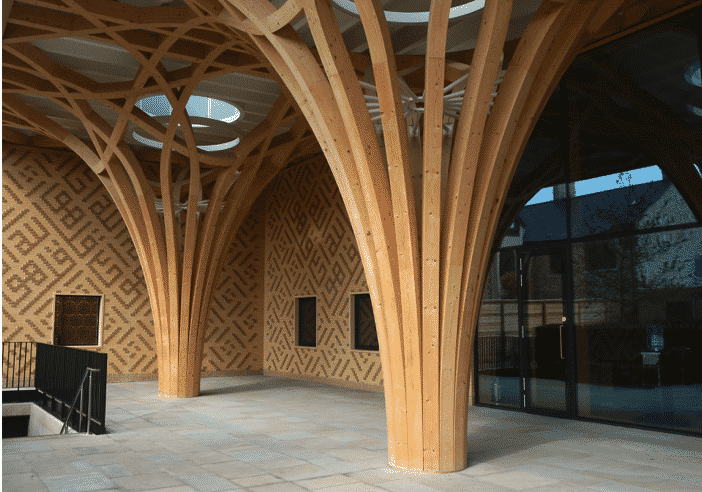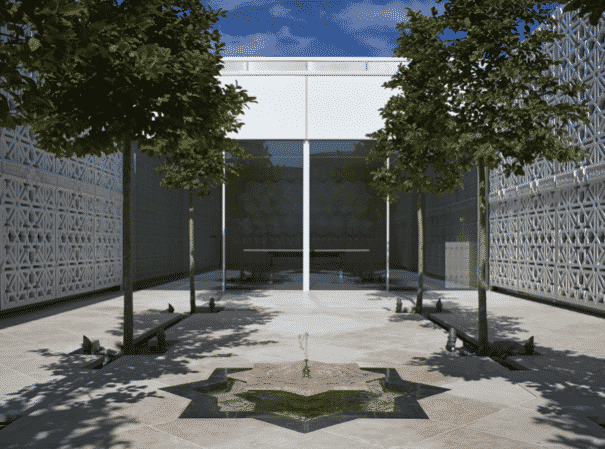The Beauty of Paradise Gardens
The Zoroastrian religion was founded on the four sacred elements air, water, earth and fire. Humans need air to breath, water to drink, fire to cook food and earth to grow plants for their survival. Zoroastrianism is the world’s oldest religion and it preceded Islam, Judaism and Christianity. The first Persian gardens were based on the four divisions of the universe, the four seasons, the four elements therefore it would be true to say that Paradise Gardens stem from the Zoroastrian religion.
People often talk about Paradise being a garden. The garden of Eden is seen to be paradise. Where does this reference come from? The word Paradise comes from the Persian word pairidaezas which means ‘Walled Garden’. The notion of Paradise as a garden predates Islam, Judaism, Christianity and even the Garden of Eden. It stems from the Sumerian period 4000BC in Mesopotamia. Shade and water are two important elements of paradise. In the epic of Gilgamesh there is a description of a tree next to a fount in the Garden of the Gods.

Credit: gardenvisit.com
The Taj Mahal is a perfect example of Moghul architecture with the onion domes and arches. In this photo one can clearly see the central water feature with the four rills that represent the four rivers of paradise. The rills bisect the garden creating the chahar-bagh.
Paradise gardens were introduced to India by the Persians some 2000 years before the Moghul invasion. Credit must go to the Persians for introduction of symmetry and geometry in the design of Paradise Gardens and not to the Moghuls or the Rajputs. However, the Moghuls do deserve credit for inclusion. They were quick to adapt and adopt. The Moghuls were Mongolian. They invaded India and created alliances with the Rajput through marriage and trade. Indo – Persian influences became very visible in the Moghul royal courts of India through architecture, administration, ceremony and indeed the designs of gardens. The world-famous Taj Mahal was commissioned by the Moghul Emperor Shah Jahan as a testament of his love for his wife Mumtaz. Although it looks like a palace it is in fact a mausoleum where Mumtaz is buried. The mausoleum is built with a vast chahar-bagh garden set out in front of it. The majesty of the Taj Mahal reflecting in the central water feature from which the four rills flow.
Moghul, Islamic, Moorish and Paradise gardens are all rooted in Iran formerly known as Persia. The enclosure of a Paradise garden was fundamental as it was a cultivated space with irrigation, a cared for area that excluded the wildness outside. The enclosure provided privacy and sanctuary for contemplation. Gardens in the west were created to walk through and enjoy. Repetition in gardens was to create rhythm. In the East geometry, symmetry and repetition created order, form and balance. This in turn took man out of chaos and into calm. When man is calm and in a meditative state of mind, he is closer to God.
 Credit: Spain Then and Now
Credit: Spain Then and Now
The Court of the Lions at the Alhambra. The circular water feature in the centre of the courtyard from which the four rills flow. A sunken chahar-bagh used to exist in this courtyard year ago, but sadly it had to be removed as it was damaging the building. Now only an orange tree in a container exists at every corner. It would benefit most certainly with a proper garden at every corner, even if containerised to bring it close to its former glory. Arabesque fretwork exists above the Islamic style arches and there is also calligraphy included within these.
The book of Genesis talks of a central spring in the Garden of Eden. From this spring flowed four rivers into the world beyond. In Paradise Gardens there is always a central water feature from which four rills flow. These represent the four rivers of paradise, milk, honey, water and wine. Water is the most important element in the garden. Without water life cannot exist. Water symbolizes the power of the sultan, the king. Fountains and chutes symbolize the resurrection of life. The central pool of water also acts as a mirror to reflect the stars and heaven thereby bring man closer to God. These gardens where often built in dry arid locations, so the moving water helped to cool the air. There is a lot of symbolism in Paradise Gardens.
Islamic art comprises of geometry, arabesque and calligraphy. Geometry represents the crystalline form of nature. Arabesque represents the intertwined flowing lines and calligraphy is the sacred language of God. These can be seen throughout the Islamic world in architecture, carpets, textiles, ceramics, Quranic illuminations and certainly in Paradise/Islamic gardens.
Geometry creates order, harmony and balance within a space. The classic chahar-bagh design (chahar = four, bagh = gardens) derives from the geometric formality of the four-fold design.
The number 1 represents unity, wholeness, the celestial world and its symbol is the circle. Number 2 represent duality and its symbol is a line. The line is juncture where separation has taken place from one point to another. Number 3 therefore creates a triangle and takes us back to our original point. It represents the journey of our soul from birth through life to death. A line from the Quran
 Credit: Designer Tom Stuart Smith and Le Jardin Secret
Credit: Designer Tom Stuart Smith and Le Jardin Secret
Le Jardin Secret in Marrakech, designed by Tom Stuart Smith shows the lapis coloured zillij tiles used for the pathways. The central water feature still exists but a modern adaptation with just one rill. The chahar-bagh has been further divided and there is a play on symmetry and geometry. reads ‘Truly we are from God and to God we shall return’. Number 4 (the chahar-bagh) is symbolized by a square or cube. It is a material number that represents everything associated with earthly life – earth, air, fire, water, heat, cold, wet, dry, childhood, youth, adulthood, old age. These numbers are all present in the geometric patterns that you see in Islamic art.
Over the years the design of Paradise Gardens has changed but in the past the planting was done at eye level. Large trenches were dug to create sunken borders. This was primarily for irrigation when the rains started but what it did do is bring the planting closer to eye level for the visitor. They would be able to indulge in the scent as they strolled along a path. Paradise gardens have always been about contemplation and a sensory experience. We now accept that gardens are good for our health and wellbeing. We appreciate the scent from plant, flowers and herbs through our sense of smell. Bird song, the gentle hum of bees and the rustling sound of leave and grasses as the wind blows stimulates our sense of sound. Rubbing our fingers on some mint, rosemary or lavender, holding oranges, lemons or pomegranates or even dipping our fingers in the water feature feeds our sense of touch. Taste is also catered for by eating the fruit, drink the juice or the water. Paradise gardens therefore provide balance in design and to our senses.
As Paradise Gardens were enclosed, fertile, irrigated, cared for spaces the planting did not just include scented plants but edible too. Date Palms, Figs and Olives were grown but it was the Arabs who introduced Oranges, Lemons and Pomegranates. Herbs were grown for scent and cooking as were roses. Plants were also grown for cosmetic purposes to create perfumes and lotions.
 Credit: Marks Barfield Architects and the Cambridge Central Mosque
Credit: Marks Barfield Architects and the Cambridge Central Mosque
The plan of the Cambridge Central Mosque clearly shows the design of the Paradise Garden that greets visitor as they enter the grounds of the mosque.
These influences travelled further west through trade along the Silk Routes. The Court of Lions at the Alhambra Palace is a majestic example of Islamic influences with its central water feature from which four rills flow, the arches with the cloistered walkways, the columns that represent palms of the desert and the Arabic calligraphy. Along with these the planting schemes were also adapted to suit the climates. You can see Cypress and Poplar trees, Oleanders, Philadelphus, Aloes, Ornamental Grasses and various other varieties of plants but there is always the underlying spirit of the original Paradise Gardens at the heart of them through geometry, a central water feature, scent, citrus, palms, arches and covered portals and the architecture.
 Credit: Photographer Manoj Malde
Credit: Photographer Manoj Malde
The Cambridge Central Mosque and the chahar-bagh garden. The central water feature still in place but this time no rills, the pathways represent the four rivers of paradise. I suspect this has been more an issue with planning, health and safety that the rills were not allowed. The garden has scented herbaceous perennials and the trees will eventually grow to cast some shade.
The influence of Paradise Gardens stretches as far as the Americas. The heritage of the Mexican hacienda stems from design influences brought over during the Spanish Conquest in the 16th Century by the Spanish Moors. This is can be seen through the hacienda with walls on all four sides, a courtyard and a central water feature that is often surrounded by flowering gardens. The Aga Khan Foundation in London has recently had their own Paradise Gardens installed with a very contemporary take. They have kept to the geometry and symmetry with the beautiful fretwork screens and the pattern within the tiled floor. The central water feature being ever present. The Cambridge Central Mosque is worth a visit. As you enter through the front gate you are greeted by the central water feature with the chahar-bagh gardens set out either side. The timber columns are shaped to remind the visitor of the palms in the desert. Geometry is used on the main doors leading into the mosque and also on the mosque floor.
Le Jardin Majorelle, in Marrakech, once owned by Yves Saint Laurent is clearly influenced by Paradise Gardens. In recent years Tom Stuart Smith has created the gardens for Le Jardin Secret. Of the two gardens one is designed in true Islamic style with the central water feature and the chahar-bagh. It is an enclosed garden with rammed earth walls and zillij tiled pathways in classic in herringbone pattern as so often seen in Paradise Gardens. These tiles are also cut and trimmed to create the intricate geometric patterns that are used to embellish walls.
 Credit: Photographer Manoj Malde
Credit: Photographer Manoj Malde
Always a nod towards the dry arid desert landscapes, here the Marks Barfield Architects have designed these incredible supports for the ceiling. These symbolize the date palms but even in these supports you can see geometry, symmetry and arabesque. Paradise Gardens will continue to influence the world of garden design. We must take advantage of these spaces to connect us to God and our own inner peace.
‘Truly we are from God and to God we shall return’ Inna lillahi wa inna ilayhi raji’un
 Credits: The Art of Islamic Garden by Emma Clark Islamic Gardens and Landscapes by D. Fairchild Ruggles
Credits: The Art of Islamic Garden by Emma Clark Islamic Gardens and Landscapes by D. Fairchild Ruggles
The Garden of Light designed by Nelson Bryd Woltz for the Aga Khan Centre in London. This a very contemporary interpretation of a Paradise Garden but the central water feature is still at the heart of the space. Less is more has really worked to create a peaceful and contemplative place set of by the beautiful geometric fretwork screens.
 Detail of the fretwork screen.
Detail of the fretwork screen.



